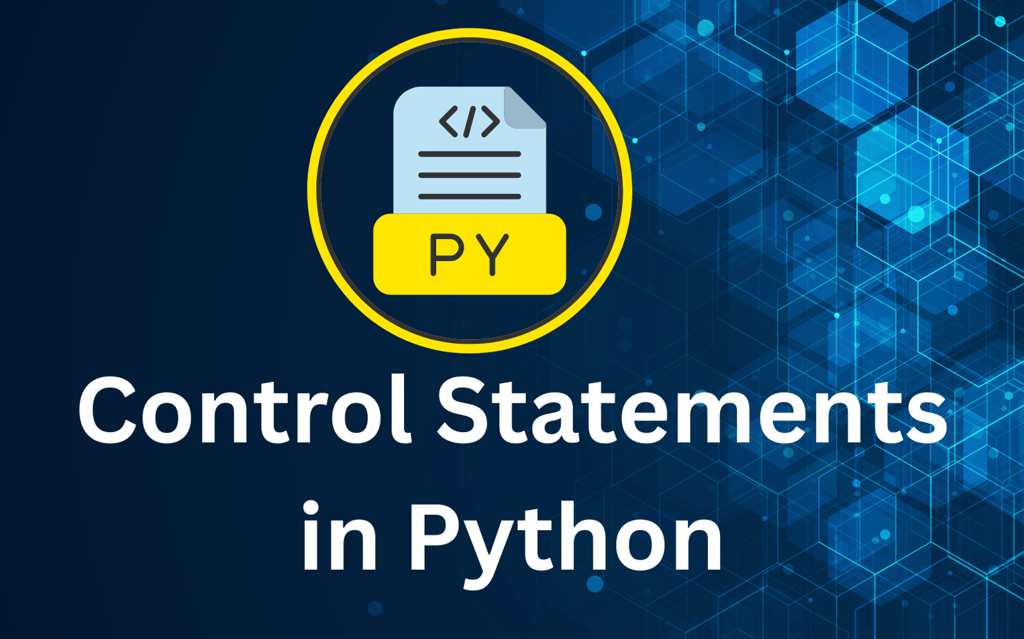🚦 Mastering Control Statements in Python
PYTHON
4/25/20253 min read


Control the Flow. Command the Logic.
Python is known for its simplicity, but beneath the clean syntax lies powerful tools that help you control the flow of your program. These tools are called control statements.
In this blog, we’ll explore three essential control statements in Python:
break
continue
pass
You’ll learn what they do, when to use them, and see real-world examples in action. Let's dive in!
What Are Control Statements?
Control statements let you change the default flow of execution in loops and conditional blocks. They help in skipping iterations, exiting loops early, or inserting placeholders.
The break Statement
Purpose:
Used to exit a loop prematurely — when a certain condition is met.
Syntax:
for item in sequence:
if condition:
break
Example:
# Stop the loop when 7 is found
numbers = [1, 3, 5, 7, 9]
for num in numbers:
if num == 7:
print("Found 7, stopping loop.")
break
print(f"Checked: {num}")
Output:
Checked: 1
Checked: 3
Checked: 5
Found 7, stopping loop.
When to Use:
Searching for an element and exiting early
Canceling infinite loops on a condition
Breaking out of nested loops (with care)
The continue Statement
Purpose:
Used to skip the current iteration of a loop and move to the next one.
Syntax:
for item in sequence:
if condition:
continue
Example:
# Skip printing even numbers
for i in range(1, 6):
if i % 2 == 0:
continue
print(i)
Output:
1
3
5
When to Use:
Ignoring specific conditions
Filtering input without exiting loop
Cleaning or validating data streams
The pass Statement
Purpose:
pass is a placeholder — it does nothing. It's used when a statement is syntactically required but you don't want to run any code (yet).
Syntax:
if condition:
pass # do nothing for now
Example:
for i in range(3):
if i == 1:
pass # you can add logic here later
print(f"Processing {i}")
Output:
Processing 0
Processing 1
Processing 2
When to Use:
Creating code stubs
Temporarily disabling logic
Structuring empty class/method definitions
Password Validator:
while True:
password = input("Enter a password: ")
if len(password) < 6:
print("Too short, try again.")
continue
if " " in password:
print("No spaces allowed.")
continue
print("Password accepted!")
break
What’s Happening:
continue restarts the loop if the password is invalid
break exits once the input is valid
Search for a Number in a List:
numbers = [2, 4, 6, 8, 10, 12]
search = int(input("Enter a number to search: "))
for num in numbers:
if num == search:
print("Number found!")
break
else:
print("Number not found.")
Output:
Enter a number to search: 10
Number found!
ATM PIN Attempts (with Max 3 Tries)
correct_pin = "4321"
for attempt in range(3):
entered_pin = input("Enter your ATM PIN: ")
if entered_pin == correct_pin:
print("Access granted.")
break
else:
print("Incorrect PIN.")
else:
print("Card blocked after 3 failed attempts.")
Finding First Negative Number in a List
numbers = [5, 3, -8, 4, -2, 7]
for num in numbers:
if num < 0:
print(f"First negative number found: {num}")
break
OUTPUT:
First negative number found: -8
Skip Empty Input
for _ in range(5):
name = input("Enter your name: ")
if name.strip() == " ":
print("Empty input! Skipping...")
continue
print(f"Hello, {name}!")
Print Only Multiples of 3
for i in range(1, 21):
if i % 3 != 0:
continue
print(i, end=" ")
Skip Words Starting with ‘a’
words = ["apple", "banana", "avocado", "grape", "apricot", "cherry"]
for word in words:
if word.startswith("a"):
continue
print(word)
OUTPUT:
banana
grape
cherry
Unimplemented Function
def process_data():
# Logic coming soon
pass
Skipping Items That Need No Action
tasks = ["send email", "call client", "meeting", ""]
for task in tasks:
if task == "":
pass # Placeholder for handling empty task
else:
print(f"Doing task: {task}")
Combining break and continue
while True:
age = input("Enter your age (or 'q' to quit): ")
if age == 'q':
print("Goodbye!")
break
if not age.isdigit():
print("Invalid input. Try again.")
continue
age = int(age)
if age >= 18:
print("You’re eligible to vote.")
else:
print("You’re not eligible yet.")
Key Takeaways: Mastering Control Statements in Python
break
Used to exit a loop early when a condition is met.
Common in search operations, input validation, or emergency stops.
Often paired with else in for loops to detect if a break didn’t occur.
continue
Used to skip the rest of the current loop iteration and move to the next one.
Helps in filtering data or ignoring unwanted conditions without breaking the loop.
Keeps your code cleaner by avoiding nested if statements.
pass
A do-nothing placeholder used when a statement is syntactically required but no action is needed.
Useful during development, in empty function/class definitions, or TODO blocks.


Kishore Babu Valluri
Senior Data Scientist | Freelance Consultant | AI/ML & GenAI Expert
With deep expertise in machine learning, artificial intelligence, and Generative AI, I work as a Senior Data Scientist, freelance consultant, and AI agent developer. I help businesses unlock value through intelligent automation, predictive modeling, and cutting-edge AI solutions.
Let's Get in Touch
marketing@deepaiautomation.com
+91 6309397994
© 2025. All rights reserved.
Industries
Manufacturing
Financial Services
Retail
Solutions
DocuMind AI - Intelligent Document Migration
InsightEdge AI - Intelligent Power BI Reporting & Analytics
DCT AI - Digital Control Tower for Intelligent Enterprise Visibility
Inventra AI - Intelligent Inventory Optimization Platform
Maintenix AI - Predictive Maintenance Intelligence Platform
PayPredict AI - Intelligent Customer Payment Prediction Platform
SegMind AI - Intelligent Customer Segmentation & RFM Analytics Platform
DataForge AI - Intelligent ETL & Analytics Modernization Platform
DataSense AI - Intelligent Data Quality & Outlier Detection Agent
